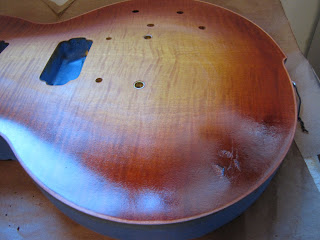First I sealed the wood with 2 wash coats of a 50/50 mix of vinyl sealer and lacquer thinner. I am using a Preval sprayer to do the spraying of the top.
Then I wiped on a honey amber stain I made using honey amber translucent dyes. I mixed 2 teaspoons of dye with 50% denatured alcohol 8 oz.. and 50% lacquer thinner 8 oz.. The picture is after I sealed it with a full strength coat of vinyl sealer.
This is after spraying the the first coat of a reddish-brown lacquer mix. I used 50% lacquer mixed with 50% stain I made which is 2 teaspoons dye to 50% denatured Alcohol 8 oz. and 50% lacquer thinner 8 oz..
This is after I scraped the binding. There were a couple of darker spots that I had to sand to thin out the coat to make it look right. But after the next coat of this is applied it should look fine. I think the dark spots were cause by me spraying the thinned out Lacquer/stain mix while the guitar was hanging. The dark spot I think are where the stain mix ran and settled right where the curve of the arch top starts. I will do the rest of the spraying of the top with it lying horizontal.

This kind of thing will make you cry. The strap on the camera hit the finish..ouch. The next step is to sand the top back to bare wood and try again.
It only took about 20 minute to sand this back to wood because I sealed the top before staining and spraying.

Here we are during the second attempt after the reddish-brown is sprayed. Much better looking this time working with the guitar horizontal. I didn't realize this until later but I forgot to seal the wood this time before I started. This will come back to bite me.

Another angle

After the brown was sprayed. Which was a mixture of 3 teaspoons brown dye to 50% denatured Alcohol 8 oz. and 50% lacquer thinner 8 oz. mixed 50/50 with lacquer. I notice some brown dots in the amber. I tried to sand them out with out going through the amber but as you can see I got some sand though. The dot were caused by me spraying from the inside of the body out. I have learned that I need to only spray from the outside in to prevent this. So guess what I get to sand this back to wood again.






